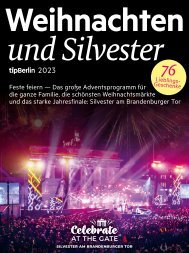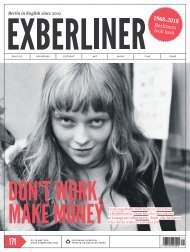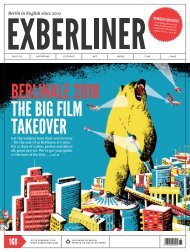EXBERLINER Issue 153, October 2016
You also want an ePaper? Increase the reach of your titles
YUMPU automatically turns print PDFs into web optimized ePapers that Google loves.
AMERICAN BERLIN<br />
LICHTENBERG<br />
BERLIN<br />
WALL<br />
SOVIET<br />
EAST<br />
BERLIN<br />
M A R Z A H N -<br />
H E L L E R S D O R F<br />
T R E P T OW<br />
Illustration by Josh Young<br />
the American Academy each year to conduct<br />
research projects and learn from each other<br />
(and the Germans). For one semester, these<br />
lucky scholars enjoy a room in the upstairs of<br />
the lakeside villa and a €5000/month stipend<br />
mostly funded by the building’s original owners,<br />
the Arnolds, a prominent Jewish banking<br />
family who had to flee during World War II.<br />
CHECKPOINT CHARLIE<br />
Here’s the only place in town where you can<br />
still have your photo taken with a GI... or an<br />
actor dressed as one, anyway. It’s all so touristy<br />
you forget this was the site of a 16-hour<br />
standoff between US and Soviet tanks in 1961.<br />
Nowadays, the recreated American Sector sign<br />
by the onetime border crossing (the original<br />
is at the Allied Museum, see #13) is more an<br />
indicator that you are entering a busy US-style<br />
business district, with buildings designed by<br />
renowned American architects including postmodernist<br />
star Philip Johnson.<br />
AMERIKA-<br />
GEDENKBIBLIOTHEK<br />
Opened in 1954 with the help of a $5 million<br />
donation from the US, the boxy building by<br />
Hallesches Tor was the first public library<br />
in Europe where bookworms could freely<br />
wander the stacks without having to order<br />
books over the counter from a librarian. It’s<br />
all about “unlimited freedom of the human<br />
mind”, according to the Thomas Jefferson<br />
quote over the entrance. The sign normally<br />
just reads “Gedenkbibliothek”, but though<br />
<strong>October</strong> 13, you can finally see “Amerika”<br />
atop the building courtesy of an artist initiative<br />
co-funded by the US Embassy. Sadly for<br />
American visitors, only a few shelves’ worth<br />
of its 900,000 books are in English.<br />
BARCOMI’S<br />
Ami cuisine is all over Berlin today (see page<br />
52), but even before White Trash, there was<br />
Cynthia Barcomi’s Kreuzberg café. The New<br />
York pioneer started selling her cheesecake<br />
and bagels in Kreuzberg in 1994; a second<br />
location, the more spacious Barcomi’s Deli<br />
in Mitte, followed soon after in 1997. It’s still<br />
one of the only places in town where the<br />
bagels are made by hand.<br />
FREE UNIVERSITY<br />
A mini-city of 28,000 in the middle of placid<br />
Dahlem, the Freie Universität was founded<br />
in 1948 under orders from US military commander<br />
Lucius D. Clay, to provide Berlin<br />
students with a place where they could<br />
study “free” from Soviet influence. These<br />
days lots of expat students, including some<br />
550 from the US, come to FU for the nearlyfree<br />
tuition (€304 per semester, but that<br />
includes a BVG pass) and the freedom to<br />
not learn German – 25 masters programmes<br />
are taught in English. You can even get a<br />
bachelor’s degree in North American Studies<br />
at the university’s JFK Institute, established<br />
in 1963. Germans, for their part, can take<br />
advantage of FU’s longstanding exchange<br />
programme with Stanford and study in<br />
California for nearly nothing. Pro tip: FU’s<br />
library is home to over 1.75 million-plus<br />
English-language books, and you don’t have<br />
to be a student there to check them out.<br />
SILVERWINGS CLUB<br />
Before Tempelhof was a park and refugee<br />
shelter, it was a US military complex. The<br />
only reminder of that time is the 1952-built<br />
Silverwings, now a somewhat cheesy German<br />
nightclub that hosts private parties,<br />
then a place where NCOs went to play<br />
pool, eat a cheeseburger and watch artists<br />
like Johnny Cash. If you had a local<br />
sweetheart, you could bring her by on<br />
weekend “German-American nights”. She’d<br />
have to exchange her deutschmarks for US<br />
dollars at the door, but as a military man<br />
you could pick up the tab with “Tempelhof<br />
Tokens”, currency distributed to soldiers<br />
to encourage them to stay on base. Times<br />
may have changed, but the décor hasn’t –<br />
you can still see the gold lacquered mosaic<br />
from the 1950s, and even the beat-up white<br />
trash can from the 1980s.<br />
ALLIED MUSEUM/<br />
OUTPOST CINEMA<br />
If you want a more legit version of Checkpoint<br />
Charlie, head to this museum in<br />
Dahlem, where you’ll find the original<br />
guardhouse building outdoors alongside<br />
the famous “You are leaving the American<br />
sector” sign and a Hastings TG 503 plane<br />
(which transported coal during the Berlin<br />
Airlift). Go inside the former Nicholson Memorial<br />
garrison library and Outpost armed<br />
forces cinema for exhibitions on the history<br />
of Berlin’s Western occupation, as well as<br />
the sign that used to flash before every Outpost<br />
screening: “National Anthem is playing<br />
now. Please wait.”<br />
TEUFELSBERG<br />
Thank the NSA for the giant, dilapidated<br />
domes protruding above the Berlin skyline<br />
in the west. Built atop a dumping zone for<br />
tens of millions of cubic metres of World<br />
War II rubble, the Teufelsberg spy station<br />
was used by American intelligence to tap<br />
into Soviet, East German, and Warsaw Pact<br />
nations’ military communications from<br />
1961 till the fall of the Berlin Wall in 1989.<br />
It’s now in the hands of investor Marvin<br />
Schütte, who magnanimously lets you check<br />
out the domes’ still-impressive acoustics on<br />
daily guided tours (€7).<br />
COLUMBIA THEATER<br />
Part of a recreation centre for US troops,<br />
the cinema near Tempelhof opened on<br />
<strong>October</strong> 13, 1951 with a screening of Captain<br />
Horatio Hornblower starring Gregory Peck.<br />
It closed soon after reunification but found<br />
new life in 1998 as a concert hall and event<br />
space; last year it was taken over by a quartet<br />
of Berlin bookers and promoters who<br />
restored its 1950s vibe and classed up the<br />
programme (American indie singer Angel<br />
Olsen hits it this month). n<br />
OCTOBER <strong>2016</strong> 15


















